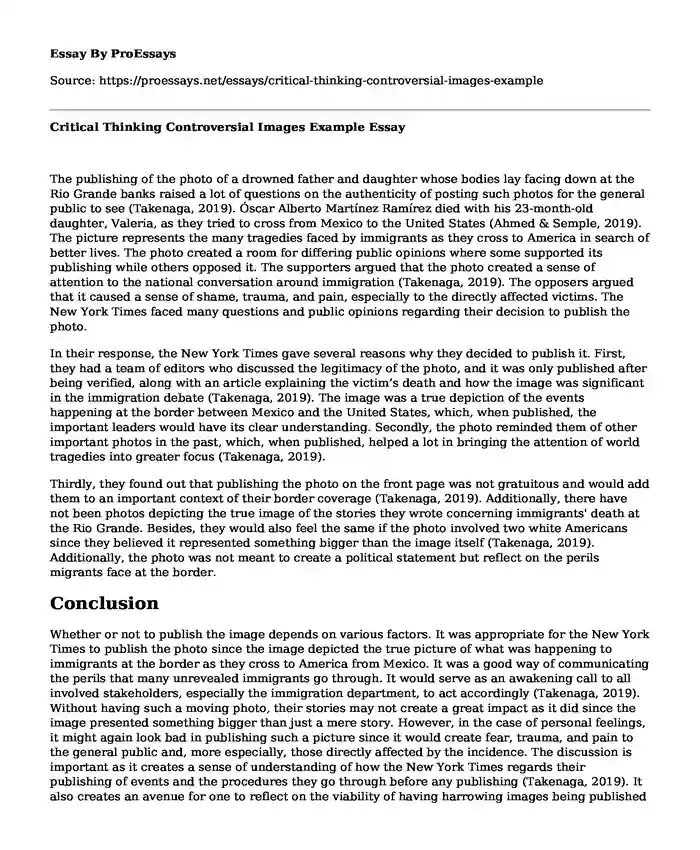The publishing of the photo of a drowned father and daughter whose bodies lay facing down at the Rio Grande banks raised a lot of questions on the authenticity of posting such photos for the general public to see (Takenaga, 2019). Óscar Alberto Martínez Ramírez died with his 23-month-old daughter, Valeria, as they tried to cross from Mexico to the United States (Ahmed & Semple, 2019). The picture represents the many tragedies faced by immigrants as they cross to America in search of better lives. The photo created a room for differing public opinions where some supported its publishing while others opposed it. The supporters argued that the photo created a sense of attention to the national conversation around immigration (Takenaga, 2019). The opposers argued that it caused a sense of shame, trauma, and pain, especially to the directly affected victims. The New York Times faced many questions and public opinions regarding their decision to publish the photo.
In their response, the New York Times gave several reasons why they decided to publish it. First, they had a team of editors who discussed the legitimacy of the photo, and it was only published after being verified, along with an article explaining the victim’s death and how the image was significant in the immigration debate (Takenaga, 2019). The image was a true depiction of the events happening at the border between Mexico and the United States, which, when published, the important leaders would have its clear understanding. Secondly, the photo reminded them of other important photos in the past, which, when published, helped a lot in bringing the attention of world tragedies into greater focus (Takenaga, 2019).
Thirdly, they found out that publishing the photo on the front page was not gratuitous and would add them to an important context of their border coverage (Takenaga, 2019). Additionally, there have not been photos depicting the true image of the stories they wrote concerning immigrants' death at the Rio Grande. Besides, they would also feel the same if the photo involved two white Americans since they believed it represented something bigger than the image itself (Takenaga, 2019). Additionally, the photo was not meant to create a political statement but reflect on the perils migrants face at the border.
Conclusion
Whether or not to publish the image depends on various factors. It was appropriate for the New York Times to publish the photo since the image depicted the true picture of what was happening to immigrants at the border as they cross to America from Mexico. It was a good way of communicating the perils that many unrevealed immigrants go through. It would serve as an awakening call to all involved stakeholders, especially the immigration department, to act accordingly (Takenaga, 2019). Without having such a moving photo, their stories may not create a great impact as it did since the image presented something bigger than just a mere story. However, in the case of personal feelings, it might again look bad in publishing such a picture since it would create fear, trauma, and pain to the general public and, more especially, those directly affected by the incidence. The discussion is important as it creates a sense of understanding of how the New York Times regards their publishing of events and the procedures they go through before any publishing (Takenaga, 2019). It also creates an avenue for one to reflect on the viability of having harrowing images being published in the articles.
References
Ahmed, A., & HYPERLINK "https://www.nytimes.com/by/kirk-semple" Semple, k. (2019). Photo of drowned migrants captures the pathos of those who risk it all. The New York Times. https://www.nytimes.com/2019/06/25/us/father-daughter-border-drowning-picture-mexico.html
Takenaga, L. (2019). Why the times published a photo of drowned migrants. The New York Times. https://www.nytimes.com/2019/06/26/reader-center/rio-grande-migrants-photo.html
Cite this page
Critical Thinking Controversial Images Example. (2024, Jan 10). Retrieved from https://proessays.net/essays/critical-thinking-controversial-images-example
If you are the original author of this essay and no longer wish to have it published on the ProEssays website, please click below to request its removal:
- Personal Statement Example: Application for Periodontal Prosthesis Residency Program
- Should We Have Same-Sex Schools: Annotated Bibliography
- Translating If and And Statements Paper Example
- Research Paper Example on Child Development
- Paper Example on Researching Childhood Depression: Causes & Treatment
- Essay Sample on Grieving Death: Moving On After Loss of a Loved One
- Unveiling Cognitive Bias in Forensic Science: A Critical Examination and Strategies for Improvement - Free Paper







